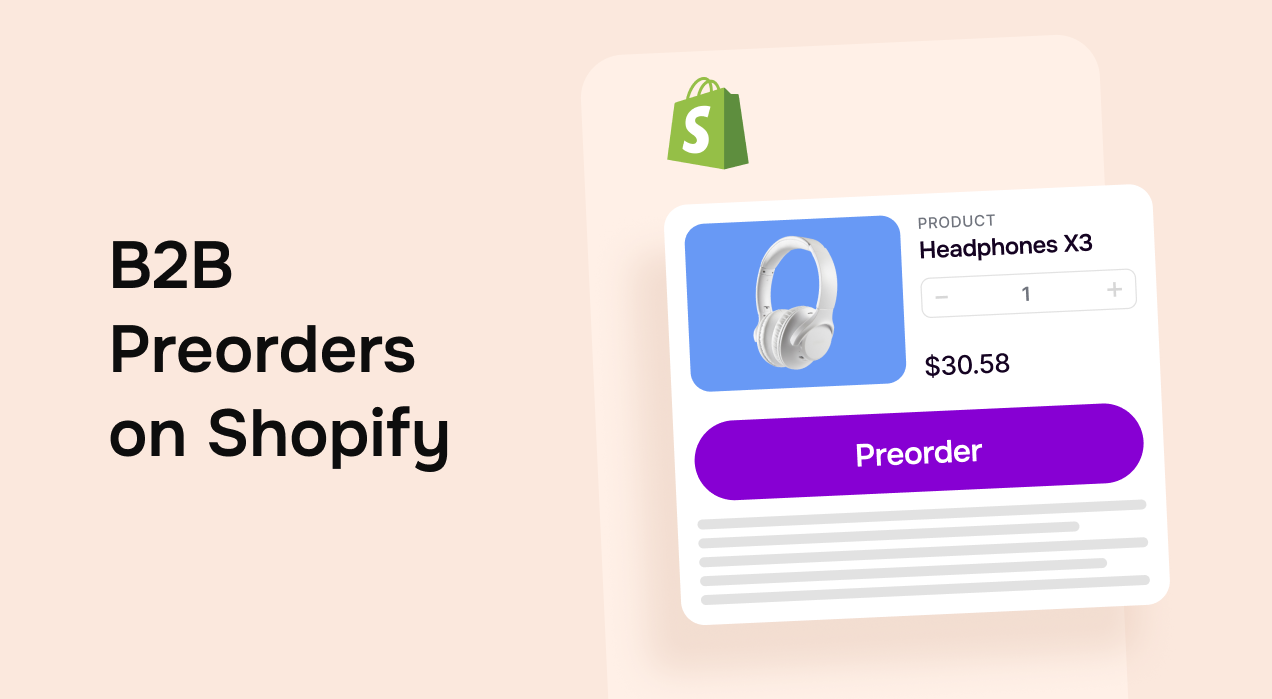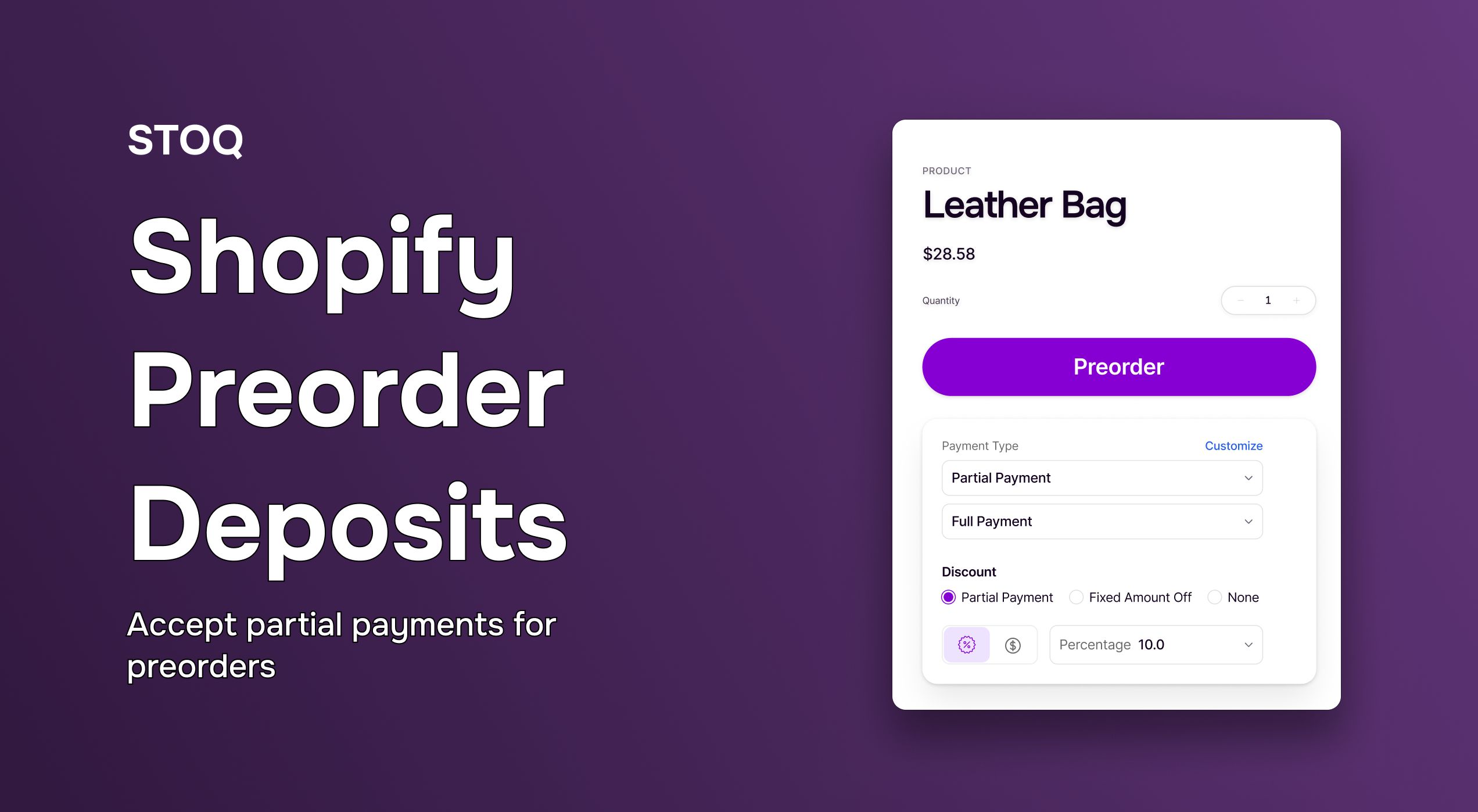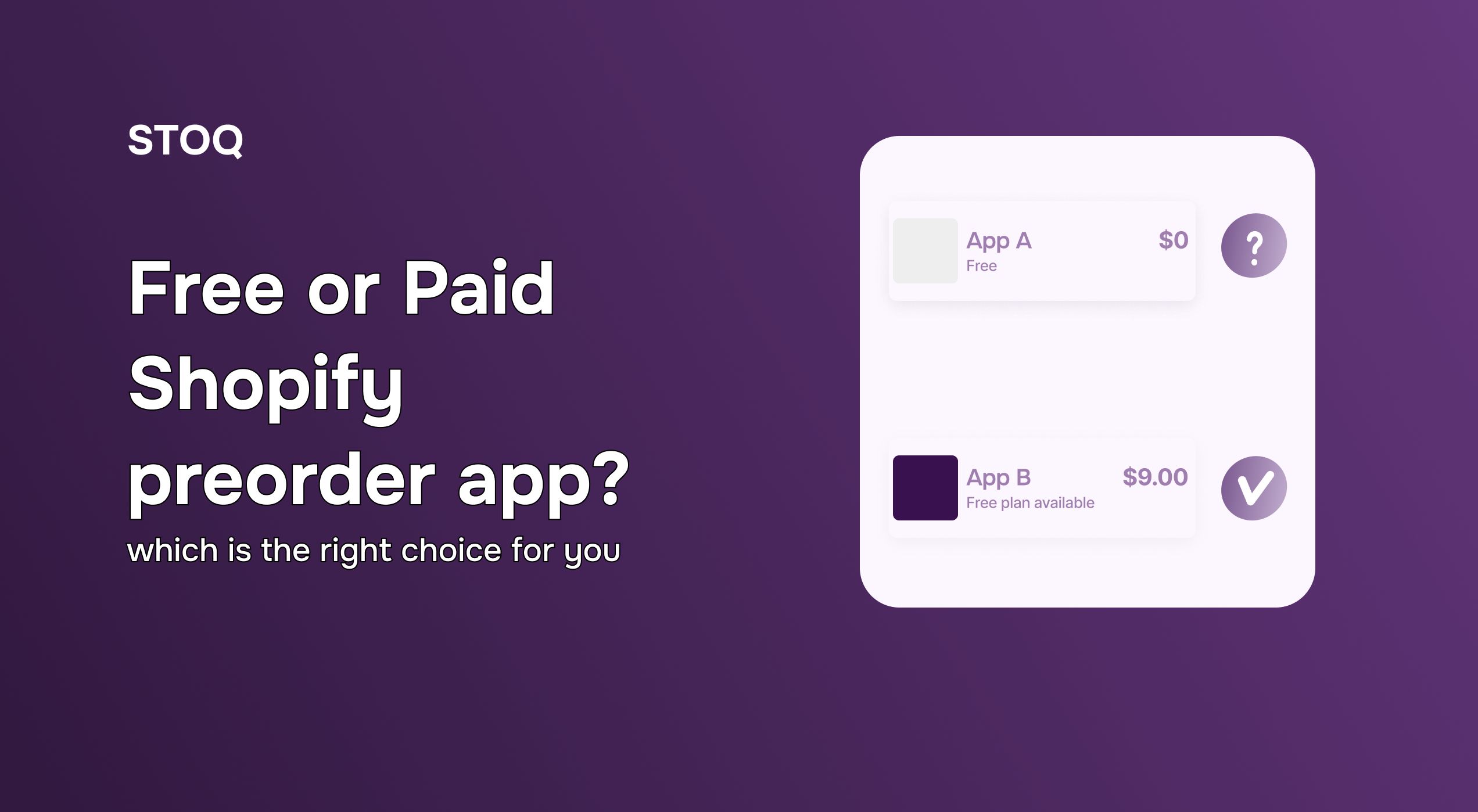The Ultimate Guide to B2B Preorders on Shopify (With STOQ)

We all know how massive eCommerce has become for D2C brands. But in the past couple of years, B2B businesses have also been rapidly moving online, and for good reason.
With the rise of B2B commerce on platforms like Shopify, brands are rethinking how they sell, restock, and scale. But let’s be honest: B2B comes with its own set of complexities. Complexities like bulk orders, long lead times, and the constant juggling act of inventory planning. That’s where preorders come in.
Pre-order is a really smart way to secure early revenue, forecast demand, and streamline operations before products even hit the warehouse. However, you need a solution to enable pre-orders — enter STOQ, a powerful Shopify app designed specifically to make B2B preorder workflows seamless.
Whether you're selling to retailers, distributors, or large clients, this guide will walk you through everything you need to know about setting up, managing, and maximizing B2B pre-orders on Shopify.
Let’s dive right in!
What Are B2B Preorders?
In eCommerce, B2B pre-orders allow businesses to sell products to other businesses before the items are in stock or manufactured. Unlike DTC (direct-to-consumer) preorders, which often focus on hype or limited drops, B2B preorders are rooted in supply chain planning. They help brands capture demand early, manage production efficiently, and build stronger buyer relationships.
Use cases vary by industry. Wholesalers can gauge interest before a major restock, manufacturers can produce based on confirmed orders, and resellers can secure high-demand items ahead of competitors.
Take a fashion brand, for example. A label showing its upcoming collection to retail partners can allow them to place pre-orders for seasonal stock. This ensures the brand only manufactures what's already sold, reducing overproduction and optimizing cash flow. B2B preorders offer predictability in a space where inventory risks and timing can make or break a business.
Why Preorders Are Critical for Shopify B2B Stores
As B2B commerce grows on Shopify, pre-orders have become more than a convenience. They have become a guarantor of purchase orders. Here's why they matter so much for B2B brands:
1. Lock in Demand to Avoid Missing Sales
With long sales cycles and high-value orders, B2B businesses can’t afford to wait until products are in stock. Preorders give buyers the ability to secure products in advance, ensuring you're not missing out on demand due to stock delays.
For example, a homeware distributor uses pre-orders to lock in bulk orders from retailers before peak season (say something like Diwali). This helps the manufacturer capture demand early and plan fulfillment accordingly, instead of losing buyers to competitors due to stock unavailability.
2. Smarter Inventory Forecasting & Batch Manufacturing
B2B pre-orders act as a real-time demand signal. When customers commit to future purchases, it gives manufacturers the data needed to produce in optimal quantities, reducing both overproduction and deadstock.
A sustainable skincare brand selling in bulk to spas opens pre-orders for its upcoming product line. Based on preorder volume, it can schedule batch manufacturing runs, ensuring efficiency and minimal waste.
3. Improved Operational Cash Flow & Order Planning
Large B2B orders often require significant investment in production and logistics. Preorders offer visibility into incoming revenue and enable better cash flow management. With confirmed orders, businesses can allocate capital with more confidence.
4. Guaranteed Volume Before Production Starts
Producing goods without confirmed buyers is risky. Preorders provide volume certainty, which is especially useful in custom or seasonal industries. It ensures you’re not left with unsold inventory or scrambling to fulfill unexpected demand.
5. Builds Trust and Transparency with B2B Clients
B2B buyers appreciate clarity, especially when lead times are involved. Preorder workflows help communicate product availability, shipping dates, and expectations clearly, improving client satisfaction and long-term loyalty.
6. Eases Restocking Pressure
Managing inventory for wholesale and large-volume clients is tough. Preorders help reduce the pressure to keep every SKU in stock at all times. Instead of overcommitting on inventory, brands can prioritize what’s already been ordered and restock smarter.
Key Features to Look for in a Shopify B2B Preorder Solution
Not all preorder apps are built with B2B needs in mind. When you're dealing with wholesale buyers, bulk quantities, and extended lead times, flexibility and automation become critical.
A powerful B2B preorder solution like STOQ should do more than just accept early orders. It should help you streamline complex workflows, scale efficiently, and deliver a professional buying experience.
Here are the key features to look for when choosing a Shopify preorder tool for your B2B store:
1. Deposit and Partial Payment Support
In B2B, it’s common to collect a portion of the payment upfront to secure an order and receive the balance later upon shipment. Your preorder tool should support flexible payment terms, like flat deposits, percentage-based partial payments, or custom invoicing.
This helps you secure early commitment from the buyer and also improves your cash flow and reduces cancellations. In fact, the early payment you get will also support your manufacturing functions.
2. Scheduled Preorder Windows
Being able to set preorder windows, specific timeframes when certain products are available to order, is crucial for managing seasonal launches, limited runs, or custom product batches. This feature allows you to create urgency and control production timelines more effectively.
For example, a fashion label showcasing its spring/summer collection to wholesale buyers can open pre-orders for just 10 days. This helps them finalize quantities and plan production accordingly.
3. Custom Messaging and Checkout Terms
Clear communication is vital in B2B. Your preorder solution should allow you to add custom messages, lead time notices, estimated delivery dates, and custom terms directly on the product page or during checkout. This transparency builds trust with wholesale buyers and minimizes confusion post-purchase.
4. Compatibility with Shopify’s B2B Toolkit and Draft Orders
Many Shopify Plus merchants use the Shopify B2B toolkit, draft orders, and customer-specific pricing. Your preorder tool should integrate seamlessly with these features, allowing you to manage custom deals, volume discounts, and exclusive product catalogs without breaking the preorder flow.
Pro Tip: Check whether the app supports pre-orders via draft orders, as many B2B merchants prefer handling large orders manually or through customer service reps.
5. Multi-location and Multi-currency Support
If you're a global B2B seller or fulfill orders from different warehouses, your preorder app needs to support multi-location inventory and multi-currency pricing. This ensures a smooth experience for international buyers and allows you to route orders more efficiently.
For example, a skincare brand selling to salons in the US, UK, and UAE can show prices in local currencies and split fulfillment from different warehouses. All of this while managing pre-orders centrally.
6. Full Integration with All Shopify Pages
Preorder functionality shouldn’t be limited to just product pages. The best solutions offer complete integration across Shopify, including collection pages, search results, quick buy widgets, featured product blocks, and custom landing pages. This ensures that wherever your buyers browse, they see consistent preorder messaging and CTA buttons.
It matters because B2B buyers often discover products through curated collections or search. If the preorder option isn’t visible or clickable from those pages, you risk losing interest and conversions.
In short, a great Shopify preorder tool for B2B needs to be flexible, scalable, and deeply integrated with your storefront and backend workflows. And STOQ fulfills each of these parameters. It will help you simplify operations and support the complexity that comes with wholesale buying. With STOQ, you get all the right features in place, making pre-orders one of your most powerful growth levers.
How STOQ Powers B2B Preorders on Shopify
As we mentioned, STOQ is purpose-built to handle the complexity of B2B pre-orders on Shopify. Designed with wholesale workflows in mind, it seamlessly integrates with your existing Shopify store without any workarounds or third-party hacks.
From capturing early demand to managing post-order communication, STOQ gives B2B brands everything they need to run smooth, scalable preorder campaigns.
STOQ supports both preorders and Shopify backorders, letting you sell products before or after stock arrives. You can easily set partial payments or deposits, perfect for high-value orders, while multi-market and multi-location preorder compatibility ensures buyers in different regions see accurate pricing and fulfillment details.
If you’re planning a limited release, STOQ’s scheduled preorder campaigns let you control when products go live. It also automates notifications via email and SMS, keeping buyers informed about order status, ship dates, or changes.
For operations teams, STOQ integrates with Shopify Flow to trigger backend actions and connects to analytics tools for tracking preorder performance. Merchants using STOQ have seen reduced inventory pressure, better forecasting, and stronger buyer satisfaction, making it a top choice for B2B brands scaling on Shopify.
Preorder Workflow Example for B2B Merchants
Let’s walk through a typical B2B preorder flow using STOQ, through the lens of a wholesale brand launching preorders for a new product line—say, wireless routers targeted at tech retailers and distributors.
1. Create Product Listing and Set Preorder Terms
The merchant creates a product listing on Shopify for the new router model, but marks it as a preorder item using STOQ. Estimated shipping dates, preorder status labels (“Ships in 4 weeks”), and preorder call-to-action buttons are automatically enabled. STOQ also allows adding custom checkout messaging, so buyers are informed of delivery timelines and payment expectations right from the product page.
2. Add Volume Limits, Deposit Rules, or MOQ
The brand sets minimum order quantities (MOQ). So let’s say MOQ is 50 units per order, then the brand allows for partial payment with a 40% upfront deposit. They also configure volume caps to prevent overselling beyond their expected production capacity (e.g., only 5,000 units available for preorder). STOQ handles these rules without needing complex customizations.
3. Schedule Preorder Campaign and Launch
Using STOQ’s scheduled preorder campaign feature, the merchant opens the preorder window for 2 weeks. During this time, bulk buyers can view the listing on the homepage, collection pages, or quick-buy widgets across the store. STOQ ensures that preorder visibility is consistent across every touchpoint, from search results to custom landing pages.
4. Set Notification and Reminder Flows
STOQ enables automated notifications to keep buyers informed. When the order is placed, an email confirms the estimated shipping date. As inventory nears restock, STOQ triggers SMS and email reminders about upcoming fulfillment and any remaining balance due. These notifications are managed via STOQ’s Shopify Flow and Klaviyo integrations, ensuring tight communication loops.
5. Transition Preorders to Fulfillment Upon Restock
Once the routers are manufactured and back in stock, STOQ automatically flags preorder orders for fulfillment. It syncs with Shopify’s inventory management system and updates the order status. For customers with partial payments, a second invoice is triggered, and the full order is released upon payment.
6. Analyze Campaign Performance and Reorder Trends
Finally, merchants can use STOQ’s analytics dashboard to review preorder KPI performance, including total units pre-sold, revenue generated, regional demand, and the most active buyers. This data feeds back into production and marketing planning for future launches.
This streamlined preorder workflow enables B2B merchants to de-risk production and improve planning, powered end-to-end by STOQ.
Best Practices for Running B2B Preorders on Shopify
Running successful B2B pre-orders on Shopify requires strategic planning and clear communication. Here are some proven best practices:
- Pricing and Discounts: Offer volume-based pricing or incentives for early orders. B2B buyers are often motivated by margins, so a small discount on preorders can drive big volume. Consider tiered pricing or limited-time preorder bundles.
- Inventory Planning: Use preorder data to plan production batches or reserve stock. Preorders give you a head start on forecasting, helping reduce excess inventory and minimize last-minute manufacturing rushes.
- Buyer Communication: Be transparent. Clearly outline delivery timelines, payment terms, and estimated ship dates at checkout. Use STOQ’s custom messaging tools to avoid surprises and build long-term trust.
- Optimization Tips: Make pre-orders visible across your site. Use badges on product images, homepage banners, or dedicated pre-order landing pages to guide B2B buyers to preorder-eligible items.
- Align Email Flows: Sync your email/SMS flows with preorder timelines like confirmation, balance payment reminders, and shipping updates so buyers stay informed at every step. It’s the difference between repeat orders and support tickets.
Conclusion
From locking in early demand to improving cash flow and optimizing inventory, preorders help businesses operate smarter and scale with confidence.
For B2B merchants navigating bulk orders, lead times, and production planning, the right preorder system can make all the difference.
That’s where STOQ comes in. Built specifically for Shopify B2B workflows, STOQ simplifies every part of the preorder journey, from deposits and MOQ rules to automated notifications and seamless integrations with Shopify’s B2B toolkit.
If you’re ready to capture revenue before inventory even lands, build stronger client relationships, and streamline operations end-to-end, STOQ is your go-to solution.
Install STOQ on your Shopify store and start accepting B2B preorders today.
FAQs About B2B Preorders on Shopify
Can I collect deposits for B2B pre-orders on Shopify?
Yes, you can collect deposits for B2B pre-orders on Shopify using apps like STOQ. STOQ allows you to accept partial payments, either as a fixed amount or percentage, at checkout, with the remaining balance collected before fulfillment.
How do I set MOQ or tiered pricing in pre-orders?
To set minimum order quantities (MOQ) or tiered pricing for pre-orders on Shopify, use apps that support wholesale rules like STOQ or Shopify’s B2B toolkit. You can define minimum units per order and offer volume-based discounts to incentivize larger purchases.
Can STOQ handle preorder limits or draft orders?
Yes, STOQ supports preorder limits by letting you cap the total number of units available for preorder. It also works with Shopify draft orders, enabling sales reps or backend teams to create and manage preorder deals manually.
How do notifications work for wholesale clients?
Notifications for wholesale preorder clients are automated through email or SMS. STOQ sends order confirmations, payment reminders, and shipping updates, and integrates with Shopify Flow and Klaviyo for advanced workflows.
Can STOQ work with ERP or fulfillment platforms?
Yes, STOQ can work with ERP and fulfillment platforms via Shopify’s native integrations or third-party connectors like Zapier or custom API setups. This allows you to sync preorder data with inventory, invoicing, and shipping systems.



.jpg)